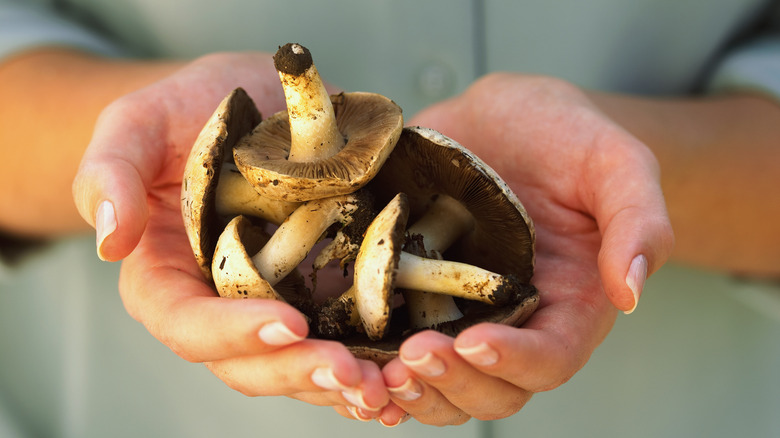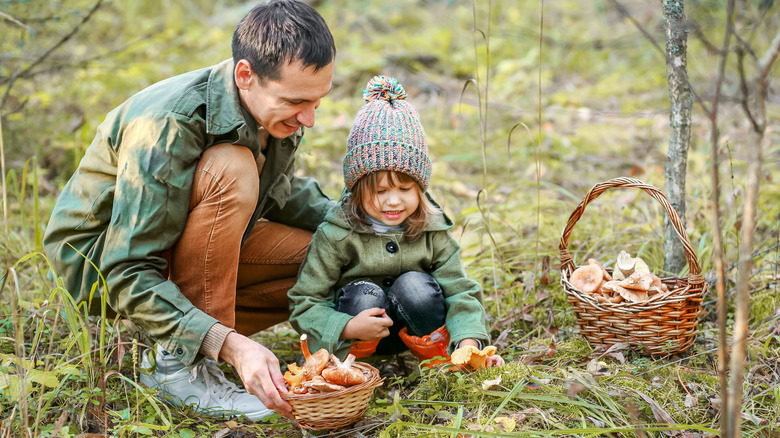The First Thing You Should Do If You Eat A Poisonous Mushroom
After heavy rain, you may notice some unexpected visitors popping up in your backyard. Coming in all shapes, sizes, and colors, there are thousands of mushroom species to be found across the globe, reports Medscape. Out of all these thousands of species, however, only about 100 of them are responsible for cases of mushroom poisoning in humans. Even fewer, only about 15 to 20 species of mushroom can put one at risk for death if eaten.
Living up to their name, some potentially-lethal species of mushroom found in North America include the Death Cap, Destroying Angel, and the Funeral Bell, amongst others, according to the Mycelium Society. Symptoms of mushroom poisoning can vary from seemingly mild to highly severe. Such symptoms include nausea, hallucinations, vomiting, liver or kidney failure, seizure, coma, or death, as per the BC Centre for Disease Control. In many instances, experts report that cases of toxic mushroom poisoning are the result of accidentally picking and eating a poisonous mushroom.
Risk of harm from mushroom poisoning
The popularity of mushroom foraging has exploded in recent years. So much so that those looking to join a mushroom club have at least 90 different existing groups to choose from between the U.S. and Canada, reports The Guardian. Unfortunately, that's a lot of opportunity for accidental consumption of a dangerous mushroom.
In a 2018 study published in Mycologia, researchers compiled data from the National Poison Data System regarding rates of mushroom poisoning in the U.S. between 1999 and 2016. The findings revealed a reported total of 133,700 cases of mushroom exposure, the majority of which had been eaten. Statistics showed that 83% of cases were reported to have been unintentional. Additionally, while mushroom exposure accounted for approximately three deaths per year, little to no harm occurred in 86% of cases. Most often, instances of mushroom exposure occurred in young children below the age of six. Therefore, it's important to know what to do should you ever find yourself in this scenario and how to intervene on behalf of an adult or child who has eaten a poisonous mushroom.
How to help an adult or child who has eaten a poisonous mushroom
After ingesting a toxic mushroom, the timing of symptoms can vary. FamilyDoctor.org reports that symptoms can come on immediately or may be delayed depending on the type of mushroom eaten. Generally speaking, symptoms that take longer to appear are indicative of a more dangerous mushroom poisoning. For instance, experts state that a symptom onset of six hours is more dangerous than a symptom onset of two hours.
If you or another person has swallowed a poisonous mushroom, you should first call the Poison Control Center at 1-800-222-1222 (via FamilyDoctor.org). Specialists will be able to walk you through first aid treatment and determine if emergency medical care is needed, according to the BC Centre for Disease Control. Alternatively, however, if the individual is experiencing more severe symptoms, such as loss of consciousness, convulsing, or isn't breathing, call 911 first (per FamilyDoctor.org).
For children, first, take the poisonous mushroom out of the child's mouth or hands and promptly call for medical assistance (via BC Centre for Disease Control). Try to keep samples of the mushroom ingested so that when speaking with poison specialists, emergency responders, or your doctor, you can describe the look of the mushroom or bring it to the emergency room in person.



